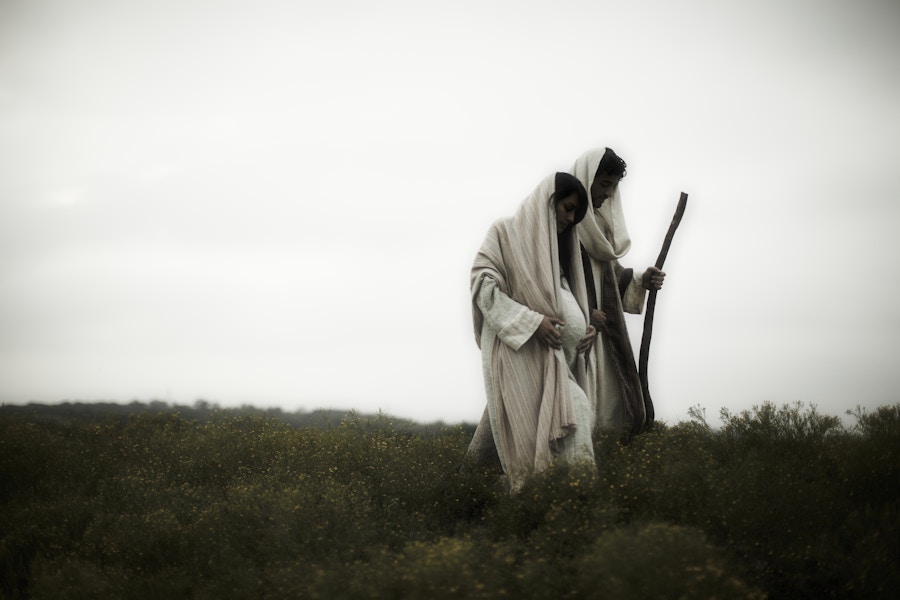The angel Gabriel was extremely busy during Advent, appearing and speaking to two people: Zechariah, the father of John the Baptist, and to a virgin from Nazareth in Galilee named Mary. Recall his visit and his unexpected, shocking, and finally, encouraging words to this young, teenage girl. “Greetings, favored one! The Lord is with you” (Luke 1:26). These words were initially “greatly troubling” to Mary (Luke 1:29) and rightly so. For what did Gabriel’s greeting mean? How could she have a child when she had never known a man? What would Joseph think? What of her future marriage? Why had Gabriel chosen to speak to her? What would Gabriel’s words demand of Mary? What would the future hold for her — and for her son? The path before her, the journey awaiting her, would be both unexpected and unfamiliar.
Yet Gabriel’s message was also pregnant with hope and expectation. For the archangel’s words were messianic words, kingdom words. God’s Anointed One, the Hope of Israel, was soon to be born, and Mary would bear him into the world. “He will be great, and will be called the Son of the Most High, and the Lord God will give to him the throne of his ancestor David. He will reign over the house of Jacob forever, and of his kingdom there will be no end” (Luke 1:32 – 33). And so the journey began for Mary — and for Joseph. Unfamiliar terrain lay ahead, for the path of the King — and for his mother — would be one of suffering, rather than glory. Indeed, the glory would shine in the suffering.
Gabriel’s words were soon fulfilled. Perhaps within minutes of Mary’s faith-filled response, cells began to replicate in her womb, cells that within weeks would develop into tiny hands and feet, arms and legs, eyes and ears, blood and bone. God was working in the holy space of Mary’s womb, weaving wonder, glory, grace, and hope. Never before had there been a conception such as this; nor such a birth; nor such a life. In a heart-beat — a moment of life-changing faith and hope — everything changed for Mary. A journey she had never expected to travel suddenly commenced.
Mary’s journey quite literally began with her sojourn with Joseph to Bethlehem, with Jesus, the promised Messiah, the Son of God and Son of Man, nestled within her. How strange, how unfamiliar, to bear God’s child. Deep hope must have rippled through her mind, soul, and body. For God had promised, through the mouth of Gabriel, and later through the words of Simeon (Luke 2:25 – 35) and Anna (Luke 2:36 – 38), that the salvation of Israel had indeed entered the world (Luke 2:30 – 32). Yet Simeon’s message, resplendent with hope, had ended on a more somber note: “And a sword will pierce your own soul too” (Luke 2:35).
As Mary’s journey with God unfolded, her hope in God’s promise was tested and tempered, refined and renewed, stretched and strengthened. The writer of the letter to the Hebrews reminds us that “faith is the assurance of things hoped for, the conviction of things not seen” (Hebrews 11:1). If, over the next 30 years of her journey with Jesus, Mary had based her trust in God’s promises on the witness of her eyes alone — on appearances — her hope might well have withered. For by all appearances — as her sweet boy died on a Roman cross — the promises made to her by Gabriel had not been fulfilled; the story had gone terribly wrong. The lay of the land looked like desert, not green pastures. By all appearances.
Again we turn to Hebrews. The writer is insistent: “Now faith is the assurance of things hoped for, the conviction of things not seen (emphasis added by author).” Yes, Mary’s sight would be immensely clarified three days after the death of her son. For, unknown to her as she watched Jesus die, resurrection awaited. Jesus’s resurrection became the compass that guided Mary as she continued to travel with Jesus through the power of the Spirit. Future events in Mary’s journey with God demanded that she continue to map her way forward through unfamiliar territory. God had proven to be full of surprises, some screamingly difficult, some warmly comforting and encouraging. Through Mary’s response of consistent faith God would teach the Church — past and present — to make its lodestar on its journey home the wonder of the resurrected Christ.
Mary, Peter, Paul, and the rest of Christ’s apprentices continued to live in hope as the years of their lives unfolded in the strange, wondrous, demanding in-between time all Christians indwell — the unexpected interval between Christ’s first and second coming. Indeed, all these early Christ-followers provide lives we can imitate — footsteps we can travel — for our own journey with God as we live, wait, anticipate, hope. Our hope as we travel with God is based on the same confidence and expectation we share with all the members of Christ’s body across the years: Christ has come, Christ has died, Christ is risen, Christ will come again. We, like Mary, will ponder, pray, weep, wonder, work, rest, and glory in the hope revealed to us in Christ.
During Advent, we focus on the beginning of the story, the birth of our living hope for the present and the future — Jesus Christ. But it is the end of the story — crucifixion, resurrection, ascension, the descent of the Spirit, and finally Christ’s return — that guides us in our journey toward home. So much of what we encounter in our life with God, our journey with Christ, will be unfamiliar — indeed, inexplicable to us — both in its wonder and its sorrow. If we judge on the basis of appearances, we will often be confused. Mary’s faith and hope teaches us a better way to travel through unfamiliar territory. “Come, walk with me,” she seems to say. “He will teach you, as he taught me. There was much I did not understand. Oh, there were times when I wept, when it seemed all hope was gone. But Gabriel was right. The promises were fulfilled. Our hope is sure. Journey on.”


